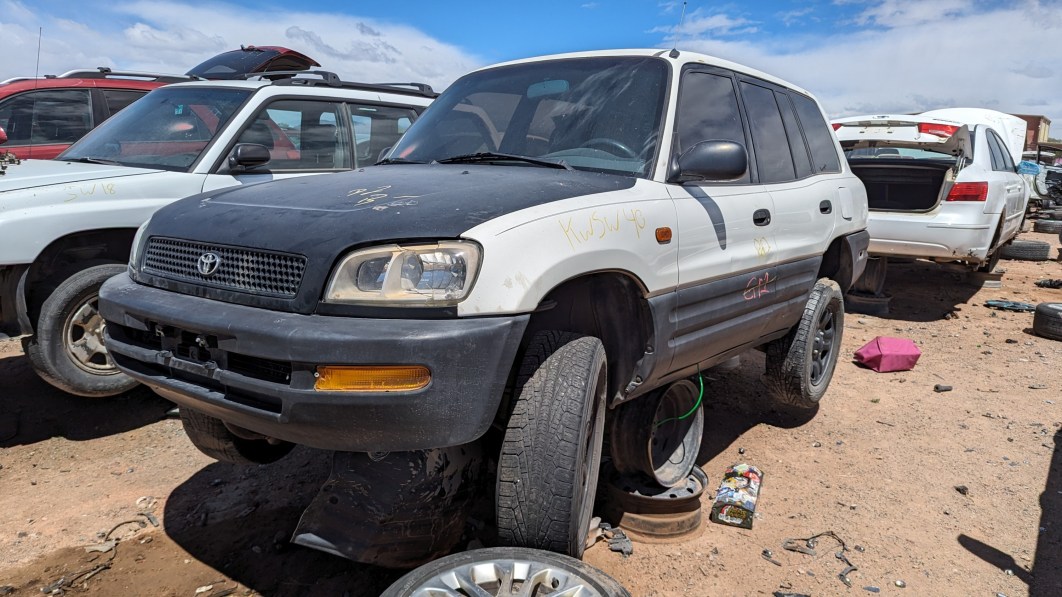The Toyota RAV4 first hit Japanese streets in the spring of 1994, but its debut in the United States had to wait until early 1996. Since that time, the RAV4 has been climbing the best-seller charts, and has spent most of the last decade as the most popular new vehicle (that isn’t a Detroit pickup) here. That’s well over 7 million units sold to American car buyers over 28 years, and today’s Junkyard Gem is one of the very first RAV4s to hit our shores.

Back in 2020, I found one of the first-ever Toyota Camrys sold in the United States (build date of February 1983, a couple of months before the initial batch of Camrys arrived here), so I’m proud to have found another Toyota milestone during my explorations of car graveyard history. I’ve also documented one of the first Mitsubishi-badged pickups sold here plus one of the first few hundred Honda Civic del Sols ever built, all in Colorado boneyards.

By the second half of the 1990s, the spectacular sales success of such machines as the Jeep Grand Cherokee and Ford Explorer had made it clear that the future of the American road would be all about trucks, and any manufacturer who failed to provide commuter SUVs that looked tough yet rode comfortably would be doomed here. Toyota was raking in tall stacks of yen with the 4Runner, but a small unibody SUV would lure even more American buyers with a nicer ride and car-like fuel economy.

The original RAV4 was developed on a chassis that borrowed from the Corolla and the Carina (which was only sold here for a couple of years in the early 1970s; the Celica was the closest Carina relative in the United States during the middle 1990s). It was available with two or four doors and with front-wheel-drive or all wheel-drive.

Following the Japanese car industry’s tradition of applying tortured acronyms to vehicle designations (e.g., Nissan PLASMA, Subaru BRAT), RAV4 stood for Recreational Active Vehicle with 4-wheel-drive. This one has front-wheel-drive and its four doors made it more about driving to work than to recreation, but you get the idea.

It was built in Aichi Prefecture in May 1996 as a “49-state” car, not legal for new sale in California.

The engine is a 2.0-liter DOHC 3S-FE straight-four, rated at 120 horsepower. We’ve seen the 3S-FE in quite a few Camrys in this series.

The base transmission for the first two generations of U.S.-market RAV4 was a five-speed manual, and that’s what’s here. When the third-generation RAV4 appeared as a 2006 model, an automatic transmission was mandatory equipment and remains so to this day (three-pedal RAV4s are still sold elsewhere on the planet). The two-door RAV4 also disappeared after 2005.

The curb weight of the 1996 RAV4 four-door was 2,778 pounds, nearly a half-ton lighter than its 2024 descendant.

This one made it a bit past 175,000 miles during its career, which is acceptable but not anywhere close to impressive by 1990s Toyota standards. During my junkyard explorations, I’ve found a 1996 Avalon with nearly a million miles, a 1996 Camry wagon with close to 600,000 miles and a 1995 Previa with well over 400,000 miles, for example.

One of the RAV4’s claims to fame is that an electric version was one of the first production EVs sold in the United States during the modern era. The RAV4 EV was launched as a 1997 model (the same year as the GM EV1, in fact) and was sold here through 2003. Unlike what happened with the EV1, Toyota didn’t confiscate and destroy all the RAV4 EVs when their leases were up and I’ve managed to find an example in a California junkyard.
Don’t drive what your neighbor drives! The problem is that now your neighbor likely does drive a RAV4.
Toyota never has been very good at pitching the whole fun thing, but their vehicles are screwed together very well.







